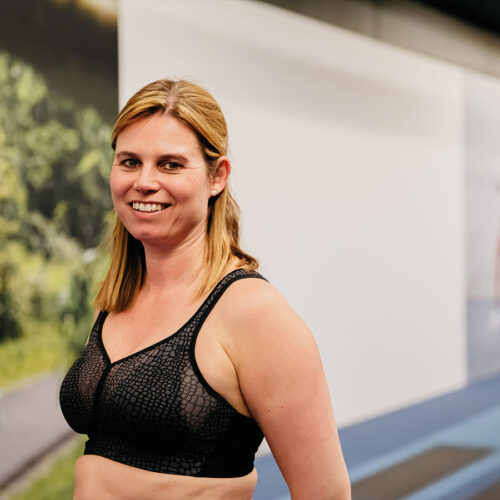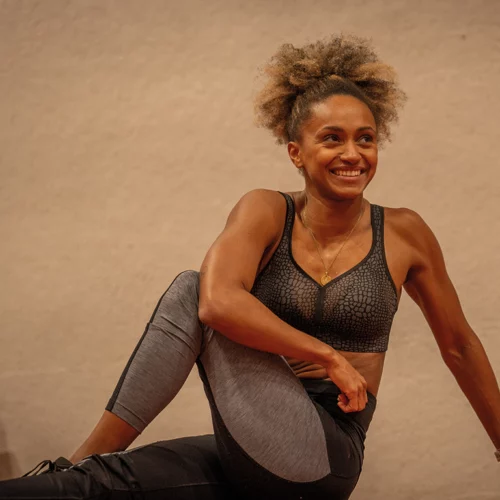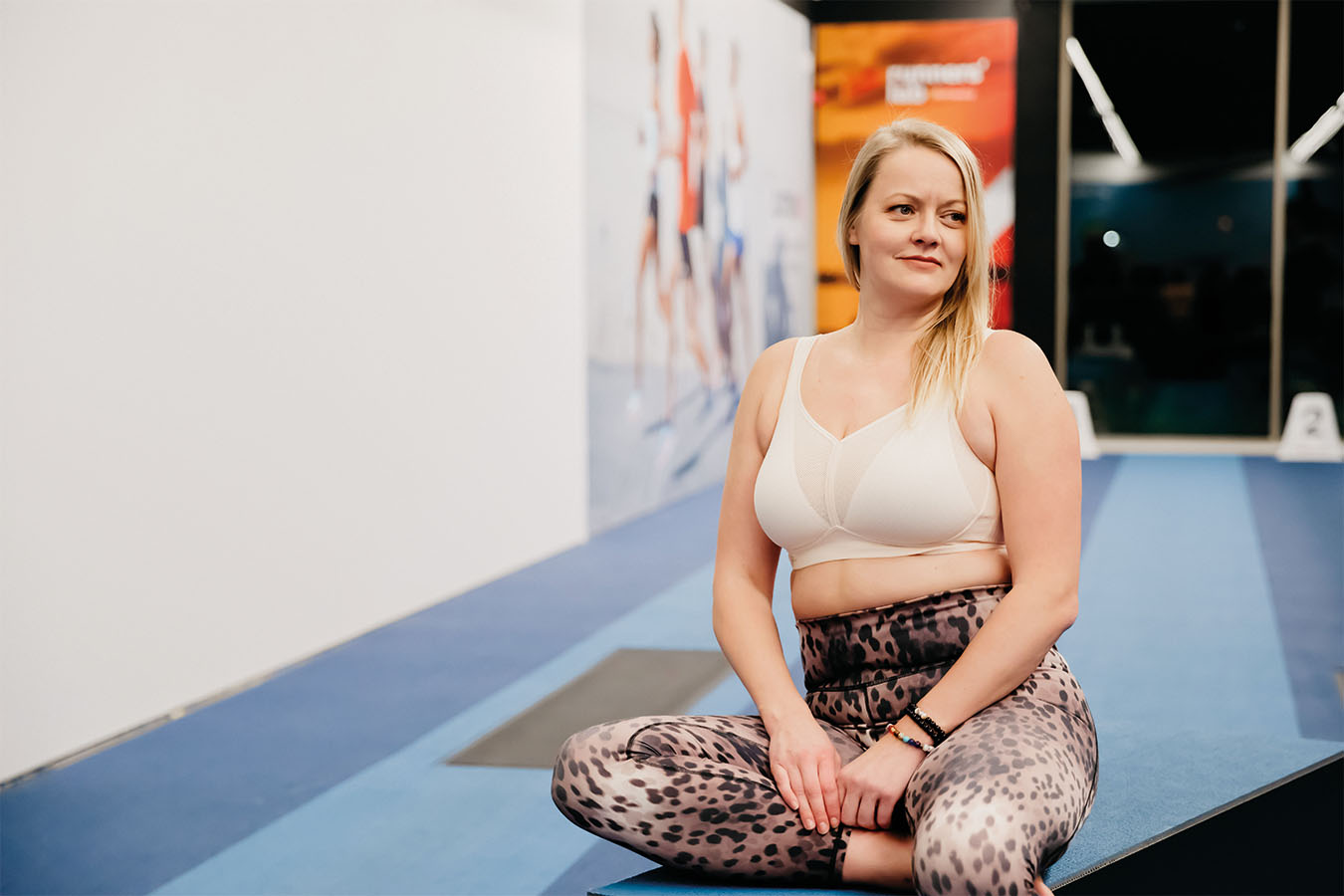Lack of motivation at one. Followed by lack of time, health AND then our two bosom friends. Among women, breasts appear to be the 4th biggest barrier to exercise. There is little we can do about the first three barriers. But we can for point 4.
Chances are you’re wearing the wrong sports bra
Because about 80% of women wear the wrong size or type of sports bra. This is despite our best efforts and two sports bra months a year. That scares you, doesn’t it? So there is a real chance that your sports bra is not quite right for you after all. Or rather, the probability is high. We probably shouldn’t tell you anymore, but we’re going to. Just to be sure. The biggest consequence of the wrong sports bra is that your breasts move too much while running.
Did you know that your breasts travel an average of 6 km during a marathon anyway? Purely by moving up and down. Even if you have a small cup size, your breasts move up and down more during running than you think. Percentage-wise, even more than for someone with a large(er) cup size.
What are the implications?
Need figures to be convinced of the importance of a good sports bra? As many as 77% of ladies complain of chest, back or neck pain during exercise. Admittedly, ladies with larger bosoms are more likely to suffer from it. Still, we don’t want to minimize the effect on athletic women with small bosoms.
More figures: the percentage of muscle tissue in the breast is 0.0. Our breast consists only of skin, ligaments, mammary gland tissue and fat. It is your skin that along with the (Cooper) ligaments provides strength. Unfortunately, the elasticity of both your skin and ligaments is not endless. If these are stretched too hard, permanent, irreparable damage can occur.
A wrong sports bra also affects your athletic performance. If your sports bra does not offer enough support, your stride length may decrease by 4 inches because of changing arm movement. Four inches sounds bitterly small. If we convert this to a distance of 42.195 km that means you have one and a half kilometers to go. A kilometer and a half that you normally had in your legs. Thus, wearing the wrong sports bra not only has a detrimental effect on your body, but also your athletic performance.
What type of sports bra should I choose?
A good sports bra minimizes movement of the breasts, keeps them in shape and protects delicate breast tissue. The selection of sports bras is vast. You basically have three types of sports bras: compression bras, encapsulated bras and a combination of the previous two. With offerings from cup sizes AA to K and circumference sizes from 65 to 110 cm, we have something for every body at Runners’ lab.
A compression bra, as the name implies, exerts compression on your breasts. Women with a cup size D or larger are less likely to recommend this type of sports bra. At least not for high-impact sports like running. They benefit more from a model with a separate compartment for each breast. This provides more support for both breasts.

What should I look for when trying on a sports bra?
Point 1: You really can’t buy a sports bra without trying it on. Unless you are familiar with the model. Otherwise, fitting is a must.
Horizontal band
The circumference band is the most important variable in fitting a sports bra. In fact, this part of a bra provides the most support. No, not the shoulder straps as many think. A too loose girth band dares to creep up while a band that fits nicely does not shift an inch. As a test, raise your arms in the air for a moment when trying on.
Nor is the reverse scenario advisable. The band should not be too tight. Can you put two more fingers between your body and the tire? Then you have the right circumference. By the way, always fit the bra at the middle or most loose position. This allows for resizing as stretch decreases through washing and wear.
Cup size
Always make sure your breasts are nicely enclosed. Your breasts should not bulge out of the sports bra, because then your cup size will be too small. There should also be no slits or openings on the top or side of your bra. This, along with folds in the material, indicates an oversized cup size. Again, you can raise your arms in the air if you are not sure. If your breast squeaks out from under it, then the cup is too small. Also note the cutout of the bra. It should not be too deep or else the upward movement of the chest will not be sufficiently countered.
Shoulder straps
Finally, the shoulder straps also deserve attention. Ideally, they should be wide and soft so they don’t cut into the shoulder. Shoulder straps can be a bit looser than the horizontal band. Looking for extra strength? Then choose crossed shoulder straps. They provide both bottom and side support.

Experiential experts speak out
Wondering how ladies experienced sports bra advice at Runners’ lab? Then read their account here.
Runners’ lab FAQs
Is the size of my sports bra the same as my regular bra?
Sports bras can sometimes be a little tighter than your daily bra. Also, one model is not the other and there is sometimes a difference from one brand to another. So it’s always best to try on a sports bra.
I have a large cup size and/or circumference. Can I find a sports bra at Runners’ lab?
At Runners’ lab, we have a wide arsenal of cup sizes and circumferences available. From cup size AA to K and circumference size 65 to 110, we have it all in our range. By the way, we also have extensions to additionally increase the circumference.
How often should I wash my sports bra?
Ideally, you should wash your sports bra after every sports session. Put your sports bra in a laundry bag, this to prevent the hooks from damaging other clothing, and wash it with liquid detergent. Definitely do not use washing powder as this will clog the pores of the technical fabric, reducing the breathability of the sports bra. Do keep in mind that after 200 washes, your sports bra will quietly need replacing. Also, a general guideline when washing sportswear is to never use fabric softener.
When do I need a high impact sports bra?
High impact sports bras are important in sports where the bra will have to absorb a lot of shocks. Examples of such sports include running, dancing, martial arts, horseback riding, mountain biking,… In sports such as weightlifting, yoga, hiking and cross-training, your breasts will not move up and down as much and a medium impact sports bra might be sufficient.
Is exercising without a sports bra unhealthy?
Yes. And this certainly does not only apply to women with larger cup sizes. Even women with a cup size A need extra support during high-impact sports. In fact, breast tissue can be damaged in them as well. At high loads, the elasticity of the tissue may decrease if the breast is not adequately supported. When this happens repeatedly, the tissue may even tear. Research shows that as many as 44% of women still regularly exercise without a sports bra, while a regular sports bra only absorbs 20-30% of the shock versus the 80% of a good sports bra.
Are pre-shaped cups or sports bras with underwire better?
Preformed cups or sports bras with underwire are certainly not better. While it is true that pre-shaped cups and underwire offer extra support to some extent, that certainly does not mean that this type of sports bra is better. This depends very much on your body type and what you are comfortable with.
I get abrasions at the level of my sports bra. What can I do?
Abrasions on the skin indicate friction combined with sweat/moisture. These irritations can be a sign of a sports bra that doesn’t quite fit the way it should after all. So this could mean that the size of your sports bra is not right or that your sports bra needs replacement. An anti-friction cream or special adhesives can relieve this irritation, but that does not eliminate the cause.

